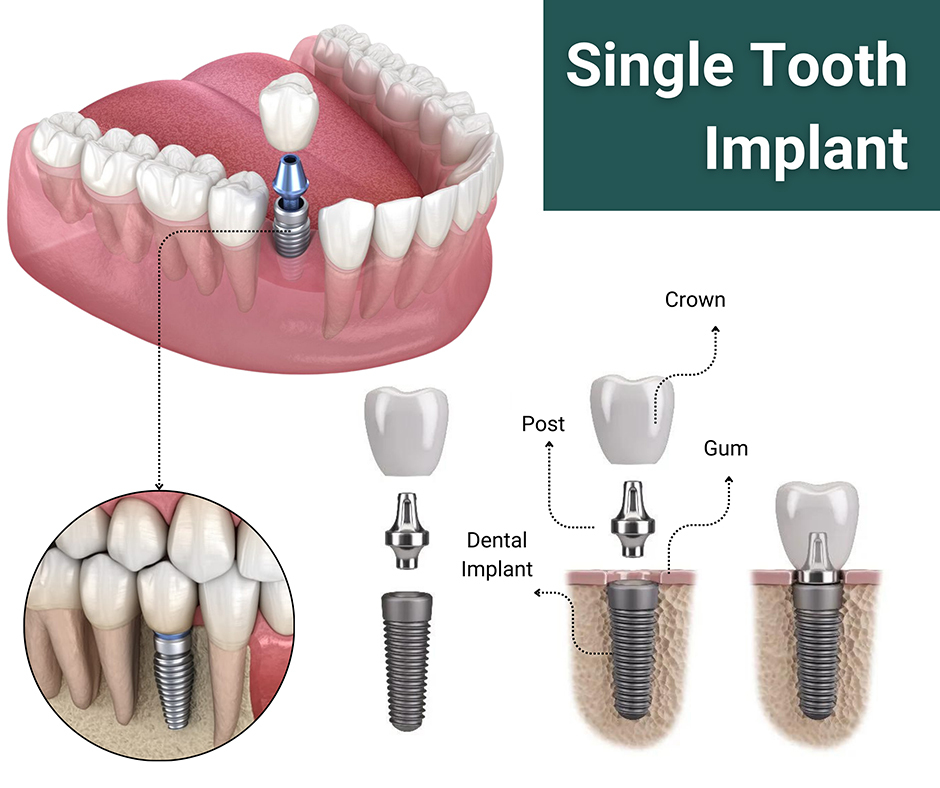Examine This Report on Dental Implants
Examine This Report on Dental Implants
Blog Article
How Dental Implants can Save You Time, Stress, and Money.
Table of Contents6 Simple Techniques For Dental ImplantsThe Ultimate Guide To Dental ImplantsThe Best Guide To Dental ImplantsGetting The Dental Implants To Work
are clinical tools surgically dental implanted right into the jaw to bring back an individual's capability to chew or their look. They provide support for artificial (fake) teeth, such as crowns, bridges, or dentures. When a tooth is lost as a result of injury or illness, an individual can experience difficulties such as fast bone loss, defective speech, or adjustments to eating patterns that lead to pain.
Framework of The Dental Implant System picking dental implants, talk to your oral copyright regarding the prospective benefits and risks, and whether you are a prospect for the procedure. Points to take into consideration: Your general health is a vital aspect in figuring out whether you are a great candidate for dental implants, the length of time it will certainly take to recover, and the length of time the dental implant may remain in area.
Smoking cigarettes may impact the healing process and lower the long-term success of the dental implant. The recovery procedure for the implant body may take numerous months or longer, during which time you usually have a short-term abutment in place of the tooth. the oral implant treatment: Thoroughly adhere to the oral health guidelines given to you by your oral company.
3 Easy Facts About Dental Implants Shown
Implant failure can lead to the requirement for one more operation to take care of or change the implant system. Brings back the ability to eat Recovers aesthetic look Assists keep the jawbone from reducing as a result of bone loss Protects the wellness of the surrounding bone and periodontals Assists keep nearby (close-by) teeth stable Improves quality of life Damage to bordering all-natural teeth throughout dental implant placement Injury to the surrounding tissues during surgery, such as sinus opening Injury during surgical treatment (for example, crack of surrounding jawbone) Insufficient function, such as really feeling like the teeth do not bite together typically A sensation that the tooth is loose or turning in position arising from a joint screw loosening Implant body failing (looseness of the implant body) due to systemic infection, which might be a lot more likely in people with uncontrolled diabetes mellitus because of regional infection in bone and gums supporting the implant body as a result of delayed recovery, which might be most likely in patients that smoke Difficulty cleaning up the periodontals around the implant, resulting in poor dental hygiene Untreated gum illness Post-surgical pins and needles due to nerve impingement or damages Always alert health care companies and imaging technicians that you have oral implants before any type of magnetic resonance imaging (MRI) or x-ray treatments.
FDA is not familiar with any kind of unfavorable events reported for MRI or x-ray treatments with dental implants. Dental implants systems are generally made of products that adhere to global agreement standards of the International Company for Standardization (ISO) or ASTM International. These criteria have information of what makes a risk-free material.
Oral dental implant systems are assessed according to global agreement criteria. Biocompatibility screening, to reveal that physical call with the tool does not trigger issues like inflammation or sensitive response, is part of the analysis that aids make sure the products in the oral implant system are risk-free and do not trigger adverse browse this site results when dental implanted in people.

The Best Strategy To Use For Dental Implants
Some individuals are not qualified for dental implant surgical procedure. It is for oral cosmetic surgeons to operate individuals with: intense illnessuncontrollable metabolic diseasebone or soft cells condition or infectionIf these problems are fixed, a person can have the surgical procedure. Dental Implants. In, dental surgeons avoid operating on people with: If individuals with any one of the above undertake oral implant surgical procedure, there is a greater danger of the implant stopping working
Some individuals have a jawbone irregularity that stops sufficient bone for a dental implant from developing. In such instances, a doctor might need to do a ridge alteration. This involves raising the periodontal to subject the location of warped bone. The cosmetic surgeon will after that make use of a bone or bone replacement to fix and accumulate the area.
Dental dental implant surgical treatment is a customized process. It's not the same for every person. However the following gives a general review of what you can expect your dental professional, dental cosmetic surgeon, periodontist or prosthodontist to do: Place the dental implant operatively. Provide you time to recover. Affix the blog post and final crown, bridge or denture.
Next, your specialist will meticulously place the oral implant right into your jaw. If your dental implant is near the front of your mouth, your dentist will certainly make a short-term tooth for you to use till you recover.
Some Known Questions About Dental Implants.
During the recovery stage, your jawbone must fuse to the dental try here implant. This process can take anywhere from 3 to nine months.
As soon as your dental implant heals, your dental expert can discover this affix the abutment (small port blog post) and your final reconstruction (crown, bridge or denture). This normally takes regarding one hour to complete and may need a 2nd small surgical procedure. You shouldn't really feel any type of pain during your oral implant treatment due to the fact that your supplier will certainly utilize medicine to numb your periodontals.
Report this page